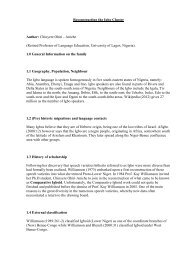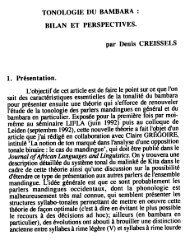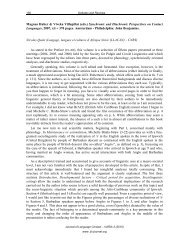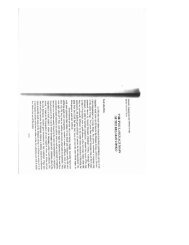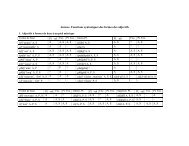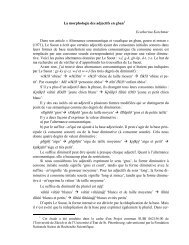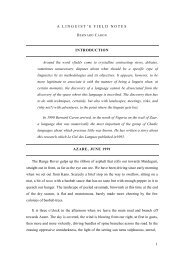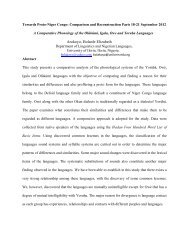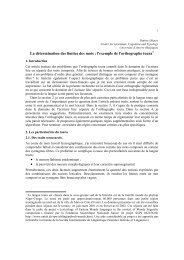Testing orthographies in the Nko and Roman scripts - Llacan
Testing orthographies in the Nko and Roman scripts - Llacan
Testing orthographies in the Nko and Roman scripts - Llacan
Create successful ePaper yourself
Turn your PDF publications into a flip-book with our unique Google optimized e-Paper software.
Joseph D. Hoover<br />
Steven Bird (1999b) exam<strong>in</strong>es <strong>the</strong> success of phonemic tone mark<strong>in</strong>g for a<br />
Grassfields Bantu language called Dschang. It uses tone to dist<strong>in</strong>guish lexical items<br />
<strong>and</strong> some grammatical constructions. See table 1 below:<br />
Table 1. Analysis of tone comprehension errors <strong>in</strong> Dschang<br />
Zero Mark<strong>in</strong>g Full Mark<strong>in</strong>g<br />
Lexical errors 0 3<br />
Grammatical errors 18 11<br />
Bird observed that <strong>the</strong> same grammatical errors were made <strong>in</strong> both <strong>the</strong> zero<br />
marked text <strong>and</strong> <strong>the</strong> full marked text though errors were less frequent <strong>in</strong> <strong>the</strong> full<br />
marked text. 2<br />
Lexical m<strong>in</strong>imal pairs are <strong>the</strong> most frequently cited reason for justify<strong>in</strong>g a tonal<br />
orthography. Never<strong>the</strong>less, Bird’s experiments demonstrated that, for those<br />
languages, full tone mark<strong>in</strong>g is worse for readers with regard to lexical identification<br />
than zero tone mark<strong>in</strong>g. He fur<strong>the</strong>r states (Bird 1999b) that:<br />
The tonal alternations <strong>in</strong> this language [Dschang] are postlexical, i.e. part of<br />
<strong>the</strong> process of utter<strong>in</strong>g words <strong>in</strong> <strong>the</strong> context of a phrase. In effect, <strong>the</strong> tone patterns<br />
serve to “glue” words toge<strong>the</strong>r <strong>in</strong>to phrases. (In this respect <strong>the</strong> system functions<br />
like English phrasal <strong>in</strong>tonation, which is not marked orthographically but for <strong>the</strong><br />
limited use of punctuation symbols such as <strong>the</strong> comma.)<br />
Therefore lexical m<strong>in</strong>imal pairs alone are not sufficient reason for mark<strong>in</strong>g<br />
lexical tone.<br />
Those with an <strong>in</strong>terest <strong>in</strong> orthography design for tonal languages would do well to<br />
read Steven Bird’s evaluation of <strong>the</strong> contributions <strong>and</strong> weaknesses of early<br />
orthography experiments by Efik, Mfonam, <strong>and</strong> Bernard (Bird 1999b).<br />
Tonal orthography design <strong>in</strong> M<strong>and</strong>en languages should<br />
be based on empirical tests<br />
Most publications <strong>in</strong> M<strong>and</strong>en languages, by foreign NGOs with which this<br />
analyst is familiar, mark tone only on <strong>the</strong> second <strong>and</strong> third person plural pronouns – if<br />
at all. Contrarily, <strong>the</strong> orthography promoted by <strong>in</strong>digenous readers of M<strong>and</strong>en<br />
languages <strong>in</strong> <strong>the</strong> grassroots <strong>Nko</strong> literacy movement marks tone fully. 3<br />
2 Similar results were observed between <strong>the</strong> full-marked orthography of <strong>the</strong> <strong>Nko</strong> script<br />
<strong>and</strong> <strong>the</strong> present near zero marked orthography <strong>in</strong> <strong>the</strong> <strong>Roman</strong> script.<br />
3 See Omniglot.com/writ<strong>in</strong>g/nko.htm for an <strong>in</strong>troduction to <strong>the</strong> <strong>Nko</strong> script.<br />
40


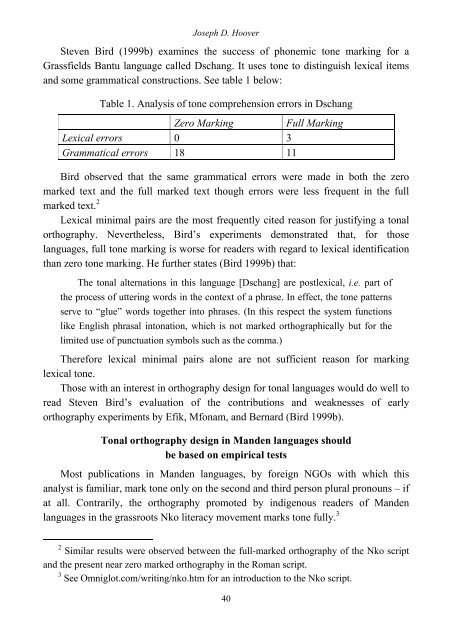
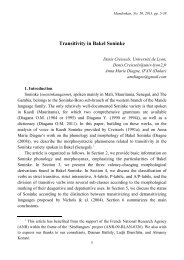
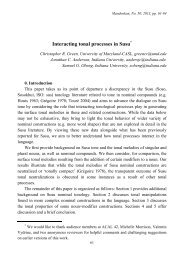
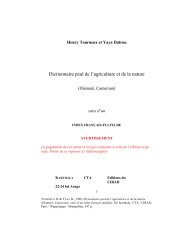
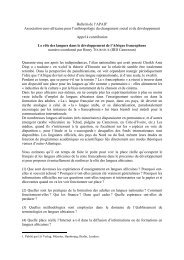
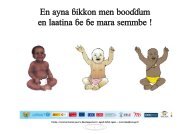
![[halshs-00645129, v1] Depressor consonants in Geji - Llacan - CNRS](https://img.yumpu.com/17832391/1/190x245/halshs-00645129-v1-depressor-consonants-in-geji-llacan-cnrs.jpg?quality=85)
